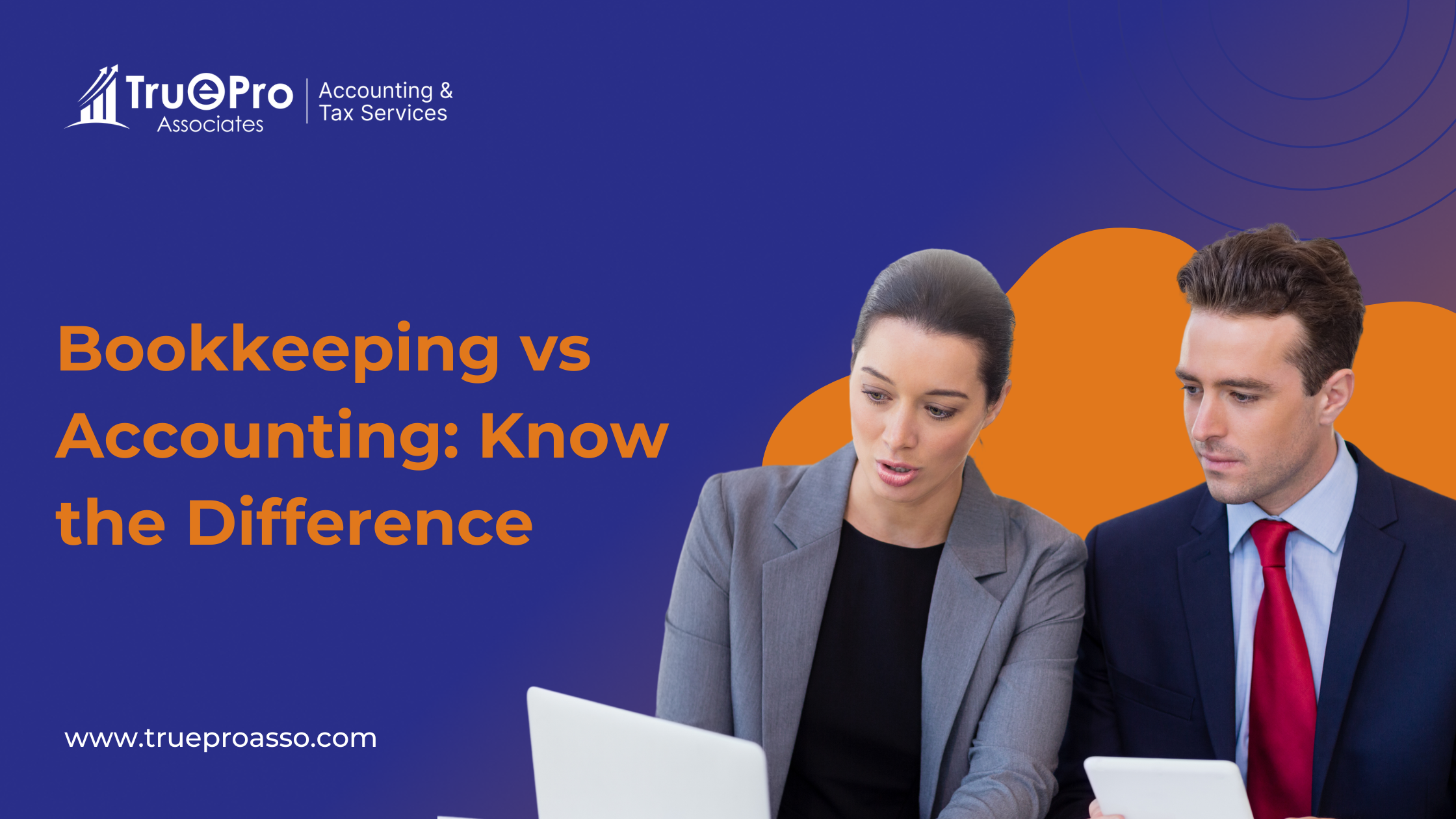If you’re self-employed, you already know that the freedom of being your boss has its challenges – especially during tax season. Managing self-employment taxes might seem daunting with all the forms, deadlines, and rules. Moreover, you’re responsible for covering the employee and employer portion of Medicare and Social Security taxes.
But what if you could make this easier and save money?
Yes, you read that right. You can claim a deduction on your self-employment tax for things like home, office, or health insurance. Through this blog, we aim to simplify the process for you, breaking down how to file self-employment taxes in 2024.
What is Self-Employment Tax?
When you run your own business, you pay self-employment tax. This includes Medicare and Social Security taxes or Federal Insurance Contributions Act (FICA) taxes for both the employee and the employer.
If you were employed by someone else, your employer would pay half your Medicare and Social Security taxes, which would be 7.65% of your earnings. However, when you’re self-employed, you’re responsible for the whole amount, which is 15.3% of your net earnings.
By paying self-employment tax, you contribute to Medicare and Social Security systems.
Although paying 15.3% of your earnings in taxes might seem huge, you can reduce half of this tax when filing your income taxes, lowering the burden of your self-employment tax.
Who Needs to Pay Self-Employment Tax?
If you’re making money through freelancing, running a small business, or driving for a ride-share company—you might wonder about self-employment tax. Understanding who is responsible and how to file self-employment tax is important for anyone working independently.
You’re considered self-employed if you operate a business as a sole proprietor, independent contractor, or gig worker, including full-time and part-time. The IRS is likely to see you as self-employed if you’re earning without being on someone else’s payroll.
Types of Self-Employment
- Gig workers (like those driving for ride-share companies)
- Freelancers and contract workers
- Sole proprietors
- Small business owners under certain business structures
If your net earnings from self-employment exceed $400 a year, you must pay self-employment tax. This rule applies to everyone, regardless of age or whether you already receive Social Security or Medicare benefits.
Exceptions and Special Cases
- Church Income: If you earn $108.28 or more from working for a church, you’re also liable for self-employment tax, even if your income is less than $400.
- Sometimes, you might need to file a tax return even if you don’t meet the $400 threshold for paying self-employment tax. This can depend on other factors like your total income.
The Self-Employment Tax Rate for 2024
The self-employment tax rate remains at 15.3% for 2024, mirroring the rate from the previous year. This rate combines Social Security and Medicare taxes, which are essential for future benefits. Let’s explain what this means for you and how to file self-employment tax effectively.
- Social Security Tax: This is 12.4% of your taxable self-employment income. It’s a key part of your future retirement or disability benefits.
- Medicare Tax: Making up the remaining 2.9%, this tax contributes to your healthcare coverage once you reach retirement age.
However, this rate applies only to the first $160,200 of your taxable income for 2024. Any earnings above this threshold are solely subject to the Medicare tax of 2.9%.
How to Calculate Your Self-Employment Tax?
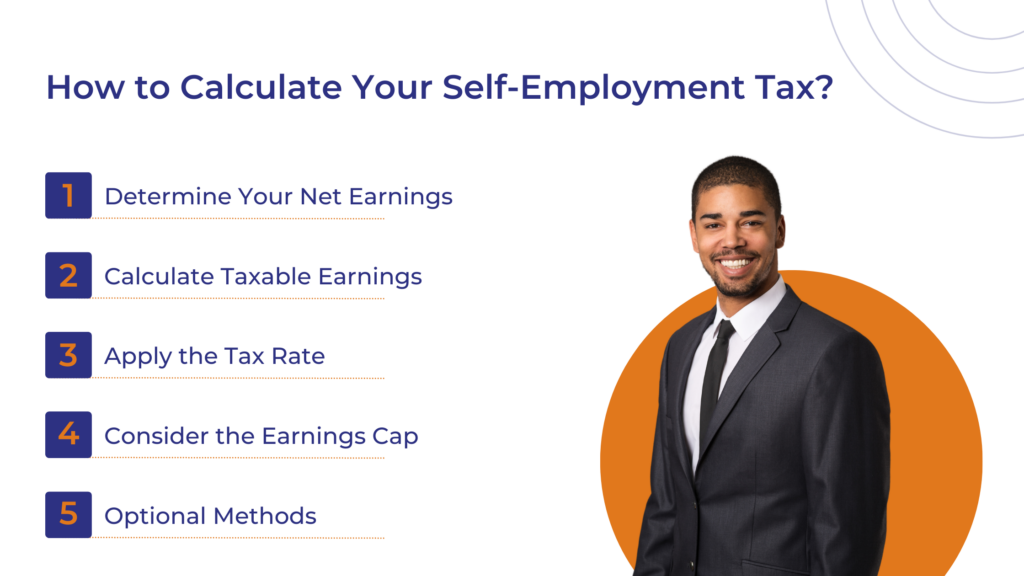
Here are the steps to calculate self-employment tax, ensuring you’re well-prepared when it’s time to file.
1. Determine Your Net Earnings
Start by calculating your net earnings from self-employment for the year. This is your gross income minus any business expenses, the amount you’ve earned after paying for the things necessary to run your business.
2. Calculate Taxable Earnings
Generally, you calculate the taxable amount by applying 92.35% to your net earnings, as you’re allowed a deduction to help cover the part of the tax that would normally be paid by an employer.
3. Apply the Tax Rate
Once you have your taxable earnings, multiply this by the self-employment tax rate of 15.3%. This rate combines 12.4% for Social Security and 2.9% for Medicare.
4. Consider the Earnings Cap
There’s a cap on how much of your earnings are subject to the Social Security tax. In 2023, this cap was $160,200, which has now increased to $168,600 for 2024. Earnings above these caps are only subject to the Medicare portion of the tax.
5. Optional Methods
If your business didn’t do well or had minimal income, the IRS Schedule SE offers two optional methods for calculating your net earnings. These methods can sometimes result in a lower tax obligation.
Let’s learn how to calculate self-employment—tax by taking the following example.
Let’s say you’re a freelance graphic designer. After deducting your business expenses, your annual net earnings are $50,000.
Calculate Taxable Earnings:
$50,000 (net earnings) x 92.35% = $46,175. This is the amount of your earnings subject to self-employment tax.
Calculate Self-Employment Tax:
$46,175 x 15.3% = $7,064.75. This is your self-employment tax for the year.
Understanding how to file self-employment tax correctly is just as important as calculating it accurately. After calculating your self-employment tax, you must report this on your tax return. Use Schedule SE (Form 1040) to calculate your exact tax due and to report it. This form will guide you through the calculation process and help you pay the correct amount.
How to File Self-Employment Tax?
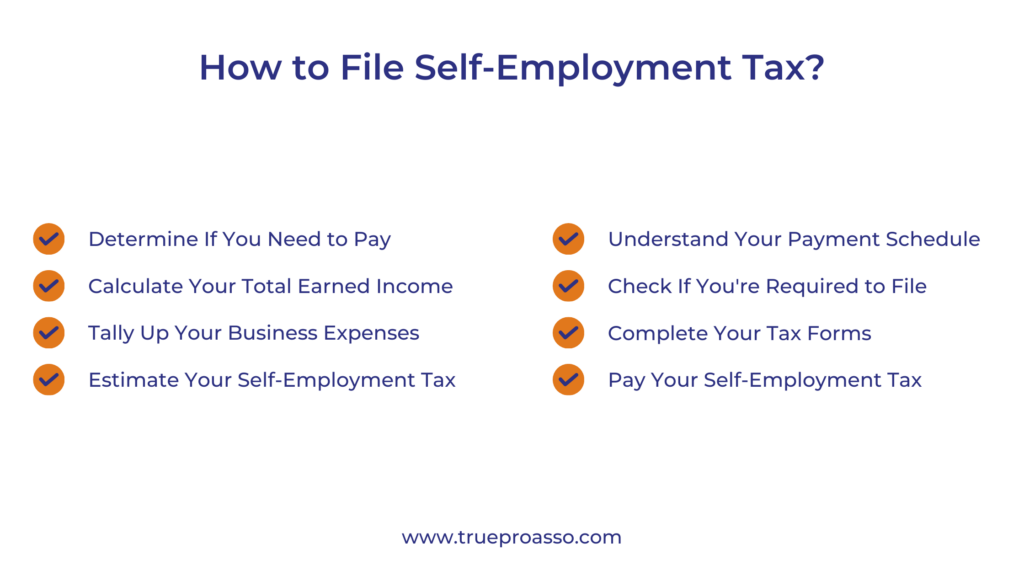
Filing self-employment tax might seem difficult. Let’s break down the process into simple steps:
Step 1: Determine If You Need to Pay
First, determine if you must pay self-employment tax. You’ll likely need to pay if you’re a sole proprietor, freelancer, independent contractor, small business owner, gig worker, or even a side hustler with W-2 income.
Step 2: Calculate Your Total Earned Income
Gather all your 1099-NEC and 1099-K forms, which report income from clients or through third-party payment processors like PayPal.
You still need to report this income if you’ve earned less than $600 from a client and didn’t receive a 1099 form. Reviewing your bank and credit card statements can help ensure you don’t miss any income that needs to be reported.
Step 3: Tally Up Your Business Expenses
Next, add up all your business-related expenses. These include office supplies, phone bills, computer and software costs, marketing expenses, and more. Deducting these expenses from your gross income will give you your net income, which is the basis for your self-employment tax. You can only deduct ordinary and necessary business expenses.
Step 4: Estimate Your Self-Employment Tax
With your net income, you can now estimate your self-employment tax. Generally, you’ll owe 15.3% of your net income in self-employment tax, covering both Social Security and Medicare taxes. For example, if your net income after expenses is $10,000, your estimated self-employment tax would be $1,530 ($10,000 x 15.3%).
Step 5: Understand Your Payment Schedule
Unlike traditional employees, self-employed individuals may need to make quarterly estimated tax payments if they expect to owe $1,000 or more in taxes for the year. These payments are due in April, June, September, and January of the following year. Making these payments can help avoid underpayment penalties.
Step 6: Check If You’re Required to File
If your net earnings from self-employment are $400 or more, you must file a tax return. This rule ensures the IRS can collect self-employment tax from you, even if your earnings are low.
Step 7: Complete Your Tax Forms
When it’s time to file, you’ll need to fill out several forms:
- Form 1040: The standard form for individual tax returns.
- Schedule C: Reports your business income and expenses to determine your net profit or loss.
- Schedule SE: Calculates your self-employment tax based on the net profit or loss from Schedule C.
- Schedule 1: Used for additional income and adjustments, including self-employment tax deductions.
Accurately filling out these forms is crucial for reporting your income and calculating how much self-employment tax you owe. Tax software or a professional tax preparer can help simplify this process.
Step 8: Pay Your Self-Employment Tax
Use Schedule SE to calculate the amount you owe based on your net earnings to pay your self-employment tax. You’ll need your Social Security number or ITIN when making payments. Consider making quarterly estimated tax payments to avoid penalties for late payments. The IRS’s free payment portal is available to make these payments directly.
Essential Tax Deductions for Self-Employed Professionals
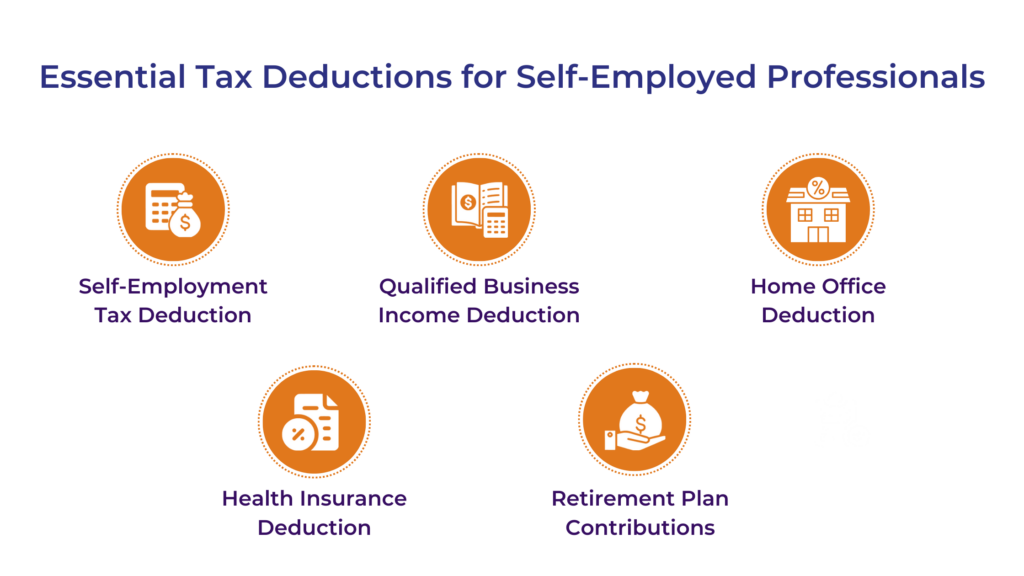
Here are some of the most beneficial tax deductions for self-employed individuals.
1. Self-Employment Tax Deduction
You can deduct half of your self-employment tax from your income taxes. For example, if you owe $2,000 in self-employment tax, you can deduct $1,000 on your Form 1040, easing the financial load.
2. Qualified Business Income Deduction
This allows you to deduct up to 20% of your net business income, significantly lowering your taxable income. However, to fully benefit from this deduction, consult a tax professional.
3. Home Office Deduction
If you use part of your home exclusively for business, you can deduct expenses like mortgage interest and utilities proportional to the size of your home office. This requires accurate documentation.
4. Health Insurance Deduction
Self-paid premiums for health insurance can be deducted if an employer’s plan does not cover you. This includes coverage for your family.
5. Retirement Plan Contributions
Contributing to retirement plans like SEP IRAs or solo 401(k) s can reduce your taxable income. However, be mindful of contribution limits.
When filing your taxes, you must complete Schedule C to report your business income and expenses, Schedule SE to calculate self-employment tax, and Form 1040 to include your income and deductions. Keep detailed records of all deductible expenses and consult with a tax professional to ensure you take full advantage of the deductions available.
By understanding and applying these deductions, you can make the most of your self-employed status and save thousands on your taxes.
Simplify Your Tax Filing with True Pro Associates
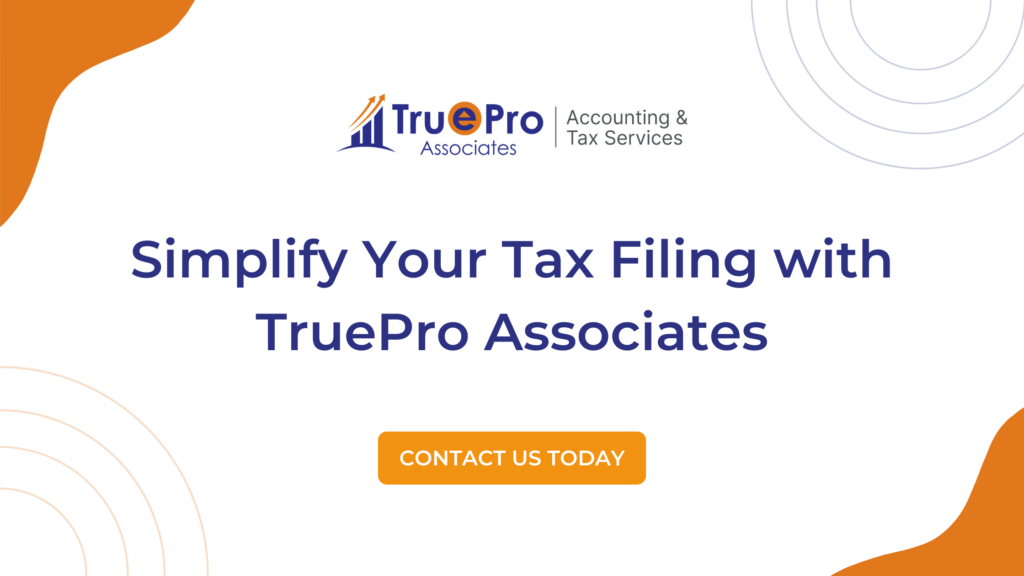
At True Pro Associates, our income tax services and accounting services are customized to provide comprehensive support for your personal and business tax needs. Our seasoned tax professionals are up-to-date with the latest tax laws and best practices.
Schedule a consultation and learn how we can assist you in achieving your tax and financial goals.
FAQs
Q1. Who needs to file self-employment tax in 2024?
Ans. Anyone earning more than $400 from self-employment activities, such as freelancing, running a small business, or gig work, must file self-employment tax. This includes both full-time and part-time self-employed individuals.
Q2. What is the self-employment tax rate for 2024?
Ans. The self-employment tax rate for 2024 remains at 15.3%, which includes 12.4% for Social Security and 2.9% for Medicare taxes.
Q3. What forms do I need to file self-employment tax?
Ans. You must complete Schedule SE to calculate your self-employment tax and report it on Form 1040. If you have business income and expenses, you’ll also fill out Schedule C.
Q4. Can I deduct any part of my self-employment tax?
Ans. Yes, you can deduct half of your self-employment tax from your income taxes, which helps lower your overall tax bill.
Q5. Are there any other deductions I should know about when filing self-employment tax?
Ans. Yes, other deductions include the home office deduction, health insurance premiums, contributions to retirement plans, and the qualified business income deduction. These can significantly reduce your taxable income.






